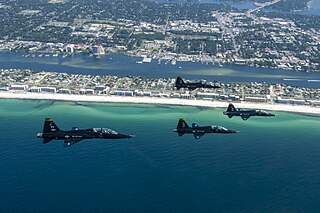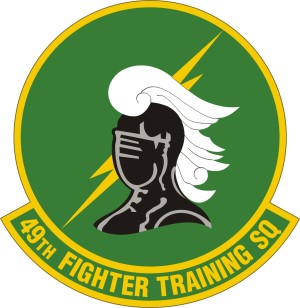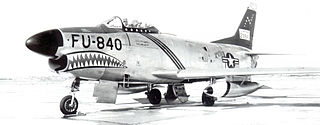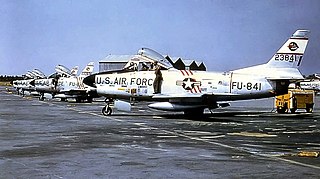
The 2nd Fighter Training Squadron, sometimes written as 2d Fighter Training Squadron, is an active United States Air Force unit, assigned to the 325th Operations Group at Tyndall Air Force Base, Florida.

The 60th Fighter Squadron is a United States Air Force unit that is part of the 33d Fighter Wing at Eglin Air Force Base, Florida; It is tasked with training pilots on the Lockheed Martin F-35A Lightning II.

The 62d Fighter Squadron is part of the United States Air Force 56th Operations Group at Luke Air Force Base, Arizona. It operates the Lockheed Martin F-35A Lightning II aircraft conducting advanced fighter training.

The 49th Fighter Training Squadron is part of the 14th Flying Training Wing based at Columbus Air Force Base, Mississippi. It operates T-38 Talon aircraft conducting flight training.

The 87th Flying Training Squadron is part of the United States Air Force 47th Flying Training Wing based at Laughlin Air Force Base, Texas. It operates T-38 Talon aircraft conducting flight training.

The 322d Fighter-Interceptor Squadron is an inactive United States Air Force unit. Its last assignment was with the 408th Fighter Group at Kingsley Field, Oregon, where it was inactivated on 1 July 1968.

The 539th Fighter-Interceptor Squadron is an inactive United States Air Force unit. Its last assignment was with the 26th Air Division at McGuire Air Force Base, New Jersey, where it was inactivated on 31 August 1967.

The 456th Fighter-Interceptor Squadron is an inactive United States Air Force unit. Its last assignment was with the Air Defense Command San Francisco Air Defense Sector stationed at Oxnard Air Force Base, California. It was inactivated on 18 July 1968.

The 329th Fighter-Interceptor Squadron is an inactive United States Air Force unit. Its last assignment was with Los Angeles Air Defense Sector at George Air Force Base, California, where it was inactivated on 1 July 1967.

The 15th Test and Evaluation Squadron is a United States Air Force unit, stationed at Eglin Air Force Base, Florida and assigned to the 753rd Test and Evaluation Group. It was first activated in the expansion of the United States military forces prior to World War II as the 15th Pursuit Squadron. It moved to Panama in 1942, where it participated in the defense of the Panama Canal. It returned to the United States, where it was a Replacement Training Unit for fighter pilots until 1944, when it was disbanded as the 15th Fighter Squadron in a reorganization of Army Air Forces training units in 1944

The 337th Flight Test Squadron was most recently part of the 46th Test Wing and based at McClellan Air Force Base, California. It performed depot acceptance testing until being inactivated with the closure of McClellan on 13 July 2001.

The 460th Test and Evaluation Squadron is an active United States Air Force unit. It was previously assigned to Tactical Air Command's 325th Fighter Weapons Wing at Tyndall Air Force Base, Florida, where it was inactivated on 15 October 1982. On 11 August 2023, it was reactivated and assigned to the 926th Operations Group, 926th Wing at Nellias AFB, Nevada.

The 445th Test Squadron is a United States Air Force squadron. It is assigned to the 412th Operations Group at Edwards Air Force Base, California. The 445th is part of the Air Force Test Center. Originally constituted in 1943 as the 445th Fighter Squadron, it was involved in the early testing of the first U.S. jets, the Bell P-59 Airacomet and later the Lockheed P-80 Shooting Star. The squadron would also be involved in flight-testing captured enemy aircraft, such as the Mitsubishi A6M Zero. During the Cold War, the unit served under the Air Defense Command as the 445th Fighter-Interceptor Squadron, flying various interceptor aircraft in defense of the Continental United States. De-activated in 1968 following a draw-down of active duty interceptor units, it was re-activated as the 6512th Test Squadron Squadron in 1969, beginning its official flight-testing mission. The unit was de-activated, re-activated, and re-designated multiple times over its life, being most recently re-activated with its current name in 2022.

The 520th Fighter-Interceptor Squadron is an inactive United States Air Force unit. Its last assignment was with 530th Air Defense Group, stationed at Geiger Field, Washington, where it was inactivated on 18 August 1955. The squadron was first activated during World War II as the 638th Bombardment Squadron, a dive bomber unit, but was disbanded before participating in combat in a general reorganization of Army Air Forces training units. It was reconstituted during the Cold War as a fighter interceptor unit supporting the air defense of the United States.

The 440th Fighter-Interceptor Squadron is an inactive United States Air Force unit. Its last assignment was with the 86th Fighter-Interceptor Wing at Erding Air Station, Germany, where it was inactivated on 1 January 1960. The squadron served as a NATO air defense unit from February 1953. The squadron was originally established as a Replacement Training Unit during World War II in February 1943, but was disbanded when the Army Air Forces reorganized its training units in 1944.

The 324th Fighter-Interceptor Squadron is an inactive United States Air Force unit. Its last assignment was with the 316th Air Division, stationed at Sidi Slimane Air Base, Morocco. It was inactivated on 8 March 1960.

The 14th Fighter-Interceptor Squadron is an inactive United States Air Force unit. Its last assignment was with the 53d Fighter Group at Sioux City Municipal Airport, Iowa, where it was inactivated on 1 April 1960.

The 13th Fighter-Interceptor Squadron is an inactive United States Air Force unit. Its last assignment was with the Minot Air Defense Sector, stationed at Glasgow Air Force Base, Montana where it was inactivated on 30 June 1968.

The 408th Armament Systems Group is an inactive United States Air Force (USAF) unit. Its last assignment was with Air Force Materiel Command's 308th Armament Systems Wing at Eglin Air Force Base, Florida. It was inactivated in 2010.























